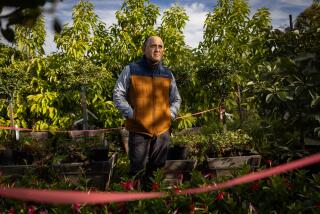Suicidal Bollworms
- Share via
If there is a proving ground these days for the kind of obstacles facing mosquito engineers, it’s three acres of cotton fields surrounded by a locked 6-foot security fence near Phoenix. Inside, three 12-by-24-foot mesh cages await the release of exactly 300 genetically re-engineered versions of Pectinophora gossypiella, better known as the pink cotton bollworm, which has devastated cotton fields from its native Australia to California’s Imperial Valley.
If and when the little pests are released, it will be the first time an insect other than the fruit fly has moved from the lab into nature. To no one’s surprise, this “live release” has attracted both scientific interest and boiling opposition. The move has been opposed by several scientists and by organizations that object to how the U.S. Department of Agriculture granted permits for the live release. The stakes, in terms of science, the cotton industry and the environment, are getting higher.
The biological maestro of this scientific and legal ruckus is an unassuming 61-year-old UC Riverside professor of entomology, Thomas Miller, right. When Miller started his quest in 1991, he did so with a breathtaking optimism that he could discover three things that perhaps didn’t exist: a gene that would cause the bug to self-immolate, a way to insert it into gossypiella’s complex genetic code, and a genetic marker that would tell scientists they had successfully inserted the lethal gene. The first bollworms to be released will have only the “marker” gene, but Miller has animals busily breeding in his labs that carry the full, lethal package.
Q: What’s ahead for the project?
Miller: There is an even chance the cage study can still be done this year despite the delays. Bob Staten [the U.S Department of Agriculture scientist supervising the live release] has it ready and waiting. He has private police patrolling the pink bollworm rearing facilities because of all the publicity and activity, and the USDA permits officer is working hard to answer all of the objections from his public announcement.
Q: This whole project must have been a massive leap of faith.
Miller: You bet. In the middle of this project, when we didn’t have any transformed pink bollworms, I was the goat because I’d been doing this for three years and no transformed pink bollworms. I wasn’t sleeping at night (laughs). And of course you can’t push a thing like that. You just have to be lucky and be around at the right time to notice the right thing happening. I can tell you this: The cotton growers were never, ever ready to drop this, at any point. They just paid the bill every year.
Q: So when you finally get a transformed insect, you start breeding them?
Miller: You’ve got to understand you’re going through a knothole. You’re mating brother and sister, and that’s a no-no in animals. You wind up with screwy animals, so the breeding process is very tricky, and you can lose the whole strain just like that.
Q: Has that happened to you?
Miller: We lost lots of strains. It’s like having a premature baby. They take enormous care or you’re going to lose ‘em. That’s another reason why, when you put DNA material into an animal, just because you’ve got it in doesn’t mean you’ve got a monster. The fact that you’ve got it in means it has excess baggage and it’s weak in comparison to other insects. Because other insects don’t have a gene jammed into them someplace.
Q: It seems like a Catch-22. You’re working on this creature, but one day you’ll have eradicated it.
Miller: You’re not going to wipe out the pink bollworm. It’ll come back. The bollworm is never going to be completely defeated because this technology we’re talking about is very expensive.
Q: Think you’ll ever get tired of doing this research?
Miller: If I don’t do this, I’ll do something else. For example, my wife and I bought a house a couple of years ago, and it’s got a lot of really tall palm trees around it. I can’t go up there and trim those stupid things, so I’m determined to make something that’ll crawl up that trunk and cut those fronds off. I have some ideas. I had scissors on balloons (laughs). I got drawings at home you wouldn’t believe.
More to Read
Sign up for Essential California
The most important California stories and recommendations in your inbox every morning.
You may occasionally receive promotional content from the Los Angeles Times.













